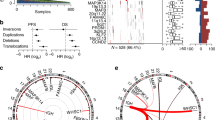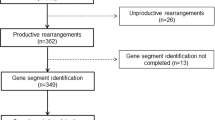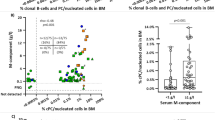Abstract
Elevated immunoglobulin free light chain (FLC) level and abnormal FLC ratio are commonly seen in multiple myeloma (MM) and have prognostic implications. We hypothesized that presence of immunoglobin heavy chain (IgH) translocations leads to unbalanced production of light chains and more extreme abnormalities of FLC, and may explain the prognostic value of FLC. We studied 314 patients with newly diagnosed MM enrolled in a phase III trial, in whom results of fluorescence in situ hybridization testing and data on serum FLC levels were available. Cytogenetic analyses and FLC estimates were performed on stored samples and results were correlated with clinical data. The median ratio (FLC ratio) and the absolute difference (FLC diff) between the involved and uninvolved FLC were higher among those with IgH translocations, especially t(14;16). In multivariate analysis, the prognostic value of FLC estimates on progression-free and overall survival were independent of high-risk IgH translocations t(4;14) and t(14;16). A combination of the risk factors; either abnormal FLC estimate and/or the presence of high-risk IgH translocation, achieved better prognostic stratification. We conclude that patients with IgH translocations have higher FLC levels and abnormal ratios, but the prognostic effect of FLC is only partially explained by translocation status. A system including both these risk factors allows better prediction of outcome.
This is a preview of subscription content, access via your institution
Access options
Subscribe to this journal
Receive 12 print issues and online access
$259.00 per year
only $21.58 per issue
Buy this article
- Purchase on Springer Link
- Instant access to full article PDF
Prices may be subject to local taxes which are calculated during checkout



Similar content being viewed by others
References
Kyle RA, Rajkumar SV . Multiple myeloma. N Engl J Med 2004; 351: 1860–1873.
Greipp PR, San Miguel J, Durie BG, Crowley JJ, Barlogie B, Blade J et al. International staging system for multiple myeloma. J Clin Oncol 2005; 23: 3412–3420.
Kyle RA, Gertz MA, Witzig TE, Lust JA, Lacy MQ, Dispenzieri A et al. Review of 1027 patients with newly diagnosed multiple myeloma. Mayo Clin Proc 2003; 78: 21–33.
Bradwell AR, Carr-Smith HD, Mead GP, Tang LX, Showell PJ, Drayson MT et al. Highly sensitive, automated immunoassay for immunoglobulin free light chains in serum and urine. Clin Chem 2001; 47: 673–680.
Katzmann JA, Abraham RS, Dispenzieri A, Lust JA, Kyle RA . Diagnostic performance of quantitative kappa and lambda free light chain assays in clinical practice. Clin Chem 2005; 51: 878–881.
Katzmann JA, Clark RJ, Abraham RS, Bryant S, Lymp JF, Bradwell AR et al. Serum reference intervals and diagnostic ranges for free kappa and free lambda immunoglobulin light chains: relative sensitivity for detection of monoclonal light chains. Clin Chem 2002; 48: 1437–1444.
Rajkumar SV, Kyle RA, Therneau TM, Clark RJ, Bradwell AR, Melton III LJ et al. Presence of monoclonal free light chains in the serum predicts risk of progression in monoclonal gammopathy of undetermined significance. Br J Haematol 2004; 127: 308–310.
Dispenzieri A, Kyle RA, Katzmann JA, Therneau TM, Larson D, Benson J et al. Immunoglobulin free light chain ratio is an independent risk factor for progression of smoldering (asymptomatic) multiple myeloma. Blood 2008; 111: 785–789.
Dingli D, Kyle RA, Rajkumar SV, Nowakowski GS, Larson DR, Bida JP et al. Immunoglobulin free light chains and solitary plasmacytoma of bone. Blood 2006; 108: 1979–1983.
Dispenzieri A, Lacy MQ, Katzmann JA, Rajkumar SV, Abraham RS, Hayman SR et al. Absolute values of immunoglobulin free light chains are prognostic in patients with primary systemic amyloidosis undergoing peripheral blood stem cell transplantation. Blood 2006; 107: 3378–3383.
Dispenzieri A, Zhang L, Katzmann JA, Snyder M, Blood E, Degoey R et al. Appraisal of immunoglobulin free light chain as a marker of response. Blood 2008; 111: 4908–4915.
Kyrtsonis MC, Vassilakopoulos TP, Kafasi N, Sachanas S, Tzenou T, Papadogiannis A et al. Prognostic value of serum free light chain ratio at diagnosis in multiple myeloma. Br J Haematol 2007; 137: 240–243.
van Rhee F, Bolejack V, Hollmig K, Pineda-Roman M, Anaissie E, Epstein J et al. High serum-free light chain levels and their rapid reduction in response to therapy define an aggressive multiple myeloma subtype with poor prognosis. Blood 2007; 110: 827–832.
Fonseca R, Barlogie B, Bataille R, Bastard C, Bergsagel PL, Chesi M et al. Genetics and cytogenetics of multiple myeloma: a workshop report. Cancer Res 2004; 64: 1546–1558.
Chng WJ, Glebov O, Bergsagel PL, Kuehl WM . Genetic events in the pathogenesis of multiple myeloma. Best Pract Res Clin Haematol 2007; 20: 571–596.
Gonzalez D, van der Burg M, Garcia-Sanz R, Fenton JA, Langerak AW, Gonzalez M et al. Immunoglobulin gene rearrangements and the pathogenesis of multiple myeloma. Blood 2007; 110: 3112–3121.
Bergsagel PL, Kuehl WM . Molecular pathogenesis and a consequent classification of multiple myeloma. J Clin Oncol 2005; 23: 6333–6338.
Avet-Loiseau H, Attal M, Moreau P, Charbonnel C, Garban F, Hulin C et al. Genetic abnormalities and survival in multiple myeloma: the experience of the Intergroupe Francophone du Myelome. Blood 2007; 109: 3489–3495.
Fonseca R, Blood E, Rue M, Harrington D, Oken MM, Kyle RA et al. Clinical and biologic implications of recurrent genomic aberrations in myeloma. Blood 2003; 101: 4569–4575.
Fonseca R, Debes-Marun CS, Picken EB, Dewald GW, Bryant SC, Winkler JM et al. The recurrent IgH translocations are highly associated with nonhyperdiploid variant multiple myeloma. Blood 2003; 102: 2562–2567.
Magrangeas F, Cormier ML, Descamps G, Gouy N, Lode L, Mellerin MP et al. Light-chain only multiple myeloma is due to the absence of functional (productive) rearrangement of the IgH gene at the DNA level. Blood 2004; 103: 3869–3875.
Szczepanski T, van ‘t Veer MB, Wolvers-Tettero IL, Langerak AW, van Dongen JJ . Molecular features responsible for the absence of immunoglobulin heavy chain protein synthesis in an IgH(-) subgroup of multiple myeloma. Blood 2000; 96: 1087–1093.
Oken MM, Leong T, Lenhard Jr RE, Greipp PR, Kay NE, Van Ness B et al. The addition of interferon or high dose cyclophosphamide to standard chemotherapy in the treatment of patients with multiple myeloma: III phase Eastern Cooperative Oncology Group Clinical Trial EST 9486. Cancer 1999; 86: 957–968.
Chesi M, Bergsagel PL, Shonukan OO, Martelli ML, Brents LA, Chen T et al. Frequent dysregulation of the c-maf proto-oncogene at 16q23 by translocation to an Ig locus in multiple myeloma. Blood 1998; 91: 4457–4463.
Radbruch A, Muehlinghaus G, Luger EO, Inamine A, Smith KG, Dorner T et al. Competence and competition: the challenge of becoming a long-lived plasma cell. Nat Rev Immunol 2006; 6: 741–750.
Shapiro-Shelef M, Calame K . Regulation of plasma-cell development. Nat Rev Immunol 2005; 5: 230–242.
Li Z, Woo CJ, Iglesias-Ussel MD, Ronai D, Scharff MD . The generation of antibody diversity through somatic hypermutation and class switch recombination. Genes Dev 2004; 18: 1–11.
Bakkus MH, Heirman C, Van Riet I, Van Camp B, Thielemans K . Evidence that multiple myeloma Ig heavy chain VDJ genes contain somatic mutations but show no intraclonal variation. Blood 1992; 80: 2326–2335.
Decourt C, Galea HR, Sirac C, Cogne M . Immunologic basis for the rare occurrence of true nonsecretory plasma cell dyscrasias. J Leukoc Biol 2004; 76: 528–536.
Cogne M, Guglielmi P . Exon skipping without splice site mutation accounting for abnormal immunoglobulin chains in nonsecretory human myeloma. Eur J Immunol 1993; 23: 1289–1293.
Morrison SL, Scharff MD . A mouse myeloma variant with a defect in light chain synthesis. Eur J Immunol 1979; 9: 461–465.
Haas IG, Wabl MR . Immunoglobulin heavy chain toxicity in plasma cells is neutralized by fusion to pre-B cells. Proc Natl Acad Sci USA 1984; 81: 7185–7188.
Kaloff CR, Haas IG . Coordination of immunoglobulin chain folding and immunoglobulin chain assembly is essential for the formation of functional IgG. Immunity 1995; 2: 629–637.
Dul JL, Aviel S, Melnick J, Argon Y . Ig light chains are secreted predominantly as monomers. J Immunol 1996; 157: 2969–2975.
Sakai A, Kawano MM, Tanabe O, Kuramoto A . A possible mechanism of inability of immunoglobulin heavy-chain production in Bence-Jones type myeloma cells. Int J Hematol 1993; 59: 31–40.
Chng WJ, Ketterling RP, Fonseca R . Analysis of genetic abnormalities provides insights into genetic evolution of hyperdiploid myeloma. Genes Chromosomes Cancer 2006; 45: 1111–1120.
Avet-Loiseau H . Role of genetics in prognostication in myeloma. Best Pract Res Clin Haematol 2007; 20: 625–635.
Avet-Loiseau H, Facon T, Grosbois B, Magrangeas F, Rapp MJ, Harousseau JL et al. Oncogenesis of multiple myeloma: 14q32 and 13q chromosomal abnormalities are not randomly distributed, but correlate with natural history, immunological features, and clinical presentation. Blood 2002; 99: 2185–2191.
Fonseca R, Harrington D, Oken MM, Dewald GW, Bailey RJ, Van Wier SA et al. Biological and prognostic significance of interphase fluorescence in situ hybridization detection of chromosome 13 abnormalities (delta13) in multiple myeloma: an Eastern Cooperative Oncology Group study. Cancer Res 2002; 62: 715–720.
Gertz MA, Lacy MQ, Dispenzieri A, Greipp PR, Litzow MR, Henderson KJ et al. Clinical implications of t(11;14)(q13;q32), t(4;14)(p16.3;q32), and 17p13 in myeloma patients treated with high-dose therapy. Blood 2005; 106: 2837–2840.
Shaughnessy Jr J, Tian E, Sawyer J, McCoy J, Tricot G, Jacobson J et al. Prognostic impact of cytogenetic and interphase fluorescence in situ hybridization-defined chromosome 13 deletion in multiple myeloma: early results of total therapy II. Br J Haematol 2003; 120: 44–52.
Chakrabarti D, Ghosh SK . Induction of syngeneic cytotoxic T lymphocytes against a B cell tumor. II. Characterization of anti-idiotypic CTL lines and clones. Cell Immunol 1992; 144: 443–454.
Halapi E, Werner A, Wahlstrom J, Osterborg A, Jeddi-Tehrani M, Yi Q et al. T cell repertoire in patients with multiple myeloma and monoclonal gammopathy of undetermined significance: clonal CD8+ T cell expansions are found preferentially in patients with a low tumor burden. Eur J Immunol 1997; 27: 2245–2252.
Acknowledgements
This study was coordinated by the Eastern Cooperative Oncology Group (RL Comis, M.D., Chair) and supported in part by Public Health Service Grants CA23318, CA66636, CA21115, and CA13650; by Grants from the National Cancer Institute, National Institutes of Health and the Department of Health and Human Services. Its contents are solely the responsibility of the authors and do not necessarily represent the official views of the National Cancer Institute.
Author information
Authors and Affiliations
Corresponding author
Ethics declarations
Competing interests
SK, AD, RF, LZ, EB, MS, RD, KH, SV, RAK, MO, PRG declare no conflict of interest. ARB is an employee of the Binding Site. JAK receives reagents from the Binding Site.
Rights and permissions
About this article
Cite this article
Kumar, S., Zhang, L., Dispenzieri, A. et al. Relationship between elevated immunoglobulin free light chain and the presence of IgH translocations in multiple myeloma. Leukemia 24, 1498–1505 (2010). https://doi.org/10.1038/leu.2010.128
Received:
Accepted:
Published:
Issue Date:
DOI: https://doi.org/10.1038/leu.2010.128
Keywords
This article is cited by
-
Genetic pathogenesis of immunoglobulin light chain amyloidosis: basic characteristics and clinical applications
Experimental Hematology & Oncology (2021)
-
Prognostic and predictive biomarker developments in multiple myeloma
Journal of Hematology & Oncology (2021)
-
Clinical and prognostic significance of t(4;14) translocation in multiple myeloma in the era of novel agents
International Journal of Hematology (2021)
-
Risk Stratification in Multiple Myeloma in Indian Settings
Indian Journal of Hematology and Blood Transfusion (2020)
-
Serum-free light chains combined with the Revised International Staging System could further distinguish the superior and inferior clinical outcome of multiple myeloma patients
Annals of Hematology (2020)



